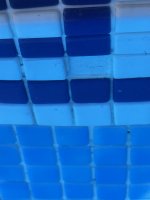We have been doing the maintenance ourselves since 2019, but we also noticed that there was black algae in some areas and that some tiles had little grout.
We first looked to see if we could easily do the maintenance ourselves and black algae became less and less, but today I had the first loose tile. I have attached a photo.
By that time we asked for advice and one company could do a renovation of the swimming pool by using a high-pressure cleaning and re-grouting service (scarping out old grout was not mentioned). This came to 600 euros, which I actually thought was cheap and gave me the idea that this was a temporary solution.
Is it true that re-grouting needs to be done once in a while?
For example, is this every 10 years (according to the neighbours, assuming correct products have been used)?
Also, the problem with the black algae will be solved they said, but it seems to me that this can also be sprayed behind tiles with the high-pressure washer and can still cause problems.
Another solution is to cut everything out and have new tiles installed, which is of course much more expensive. If I use the TFP method from the beginning, what is the expectation that a renovation will need to be done?
Ultimately, everything in life needs maintenance and I am looking for the best long-term solution. Can you help me get started in terms of information, so I can find the right professional in my area?
Many thanks,
Dominique

We first looked to see if we could easily do the maintenance ourselves and black algae became less and less, but today I had the first loose tile. I have attached a photo.
By that time we asked for advice and one company could do a renovation of the swimming pool by using a high-pressure cleaning and re-grouting service (scarping out old grout was not mentioned). This came to 600 euros, which I actually thought was cheap and gave me the idea that this was a temporary solution.
Is it true that re-grouting needs to be done once in a while?
For example, is this every 10 years (according to the neighbours, assuming correct products have been used)?
Also, the problem with the black algae will be solved they said, but it seems to me that this can also be sprayed behind tiles with the high-pressure washer and can still cause problems.
Another solution is to cut everything out and have new tiles installed, which is of course much more expensive. If I use the TFP method from the beginning, what is the expectation that a renovation will need to be done?
Ultimately, everything in life needs maintenance and I am looking for the best long-term solution. Can you help me get started in terms of information, so I can find the right professional in my area?
Many thanks,
Dominique


